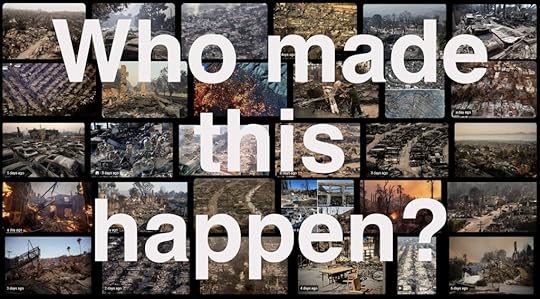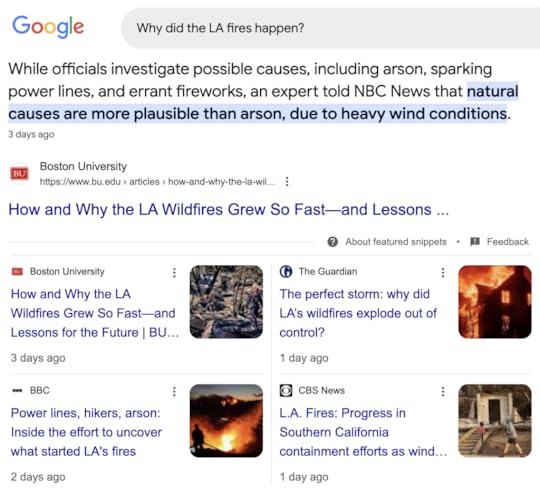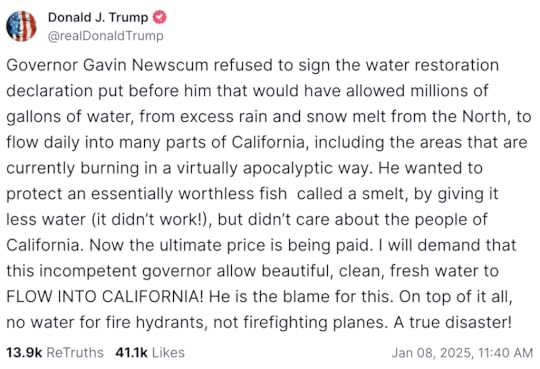The Blame Game
Twenty-third in the News Commons series
 Images from a Google image search for “LA fires aftermath.” Sources listed below.†
Images from a Google image search for “LA fires aftermath.” Sources listed below.†Disaster coverage tends to go through four stages:
Live reporting. TV stations stop all advertising and go into round-the-clock coverage. Radio stations drop the feeds from elsewhere and go wall-to-wall with live reports. Newspapers drop their paywalls. Coverage by the best of them ranges from good to heroic. As stories go, they are all about the problem.Human interest. The worst is over, so the stories go to human loss, resourcefulness, forbearing, kindness, and mendacity. Reporters on TV stand in front of some hellscape and talk to victims, heroes, or anyone they can find. This leverages the need for characters and their problems, with stories about how they survived, who or what they lost, always at least with hints toward movement forward.Blame. This is all about character. Reporters are taught to seek the five W’s: Who, What, Where, When, and Why, sometimes appending an H for How. But since stories always require characters, Who is what matters most.Coming to an understanding. While that’s the goal, and something nearly everyone wants, it’s provisional while the story continues. Also, full understanding, if it ever comes, will be at the end. And stories like the LA fires may never end, because there are contexts for them that may never change.But that’s where we are now. In Stage 4. Here’s a Google search I just did:
Note that all of these stories are one to three days old. All of them are provisionally conclusive (meaning they still keep the story going). And all of them are less interesting than Stage 3: Blame.
I want to focus on that because blame makes story-telling—and story-generating—easy. Too easy.
That’s why Donald Trump—the best story-generator (and blame-placer) the world has ever known (and I mean this seriously)—wasted no time fingering Gavin Newsom:
Politifact spent 942 words explaining, among other things, that there was , that a “water restoration declaration” never existed, that the smelt thing concerned water for elsewhere, and that what Trump said was wrong in other ways. But, as Ronald Reagan said, If you’re explaining, you’re losing. And Trump never loses, because that’s out of character. (Again, I mean this seriously. We’re talking stories here. The man is all-character, all the time.) And it is impossible for the media, which now includes everybody, not to participate in his story processes.
Of course, stories being what they are, Trump has hardly been alone in playing the blame game. Scott Galloway:
LAFD Chief Kristin Crowley took time out from fighting the fires to blame Mayor Karen Bass for cutting $17.6 million from the department’s budget. The department’s $895 million budget actually increased by $58 million as a result of the latest union contract. To get that higher pay to firefighters, the department reduced spending on equipment and training. The mayor’s response added to the drama, fueling rumors that the chief had been fired. Right-wing podcasters blame Fire Chief Crowley’s gayness, saying she was a DEI hire. Note: She has outstanding qualifications.
For all the good work being done at Stage 4, the urge to blame will never cease.
And we need some. Justice demands it.
What kind of justice? Well, there are many: retributive, distributive, restorative, procedural, social, environmental, economic, and so on. Of all those, retributive justice is what people want most and best understand. Perpetrators must be found, punished, and made to pay.
But starting with blame is too easy, too simple, often wrong, and always incomplete. Other factors matter. Conditions. Contexts. Black swans.
That’s why coming to an understanding is far more important, especially if we want to minimize or avoid the same kinds of disasters in the future. That’s what I’ll visit in my next series of posts.
Meanwhile, some of my open tabs:
LA Times: How to help those affected by fires raging across Los Angeles County.KNBC/4: Asher Bingham, an LA artist, is drawing pictures of houses lost in the fire. “What I’m fascinated with is taking something from a picture and building a story to it,” she tells “So Asher picked up a pen and shared the artwork to Instagram with a simple offer to anyone that has lost a home in the LA fires. ‘I will draw your home for free… Three million views on that video later, there is now a waiting list of hundreds of requests.”Wired: Los Angeles Needs to Fireproof Communities, Not Just Houses.Business Insider via MSN: I’m a pilot flying a DC-10 fire bomber to battle the LA fires. This is what I’ve seen — and this is what needs to stop.Kwaai Events: Fire Resilience & Beyond with Personal AI Hackathon 2025 – $30K in Prizes.Washington Post: A key ‘weakness’ in L.A.’s wildfire strategy went unaddressed for years, Post probe shows.† Sources via Google Image search: Reuters, NBC News, Marketwatch, ABC News, Hindustan Times, ABC, NPR, USA Today, The Indian Express, Nevada Appeal, YouTube, Commercial Observer, East Bay times, CBC, India TV News, Urban Land Magazine, Hope Standard, TMZ, Yahoo, Bloomberg, Instagram, and iObserve.
Doc Searls's Blog
- Doc Searls's profile
- 11 followers





